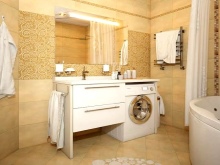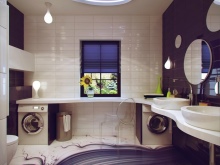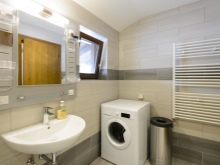Choosing a washing machine in the bathroom - expert advice
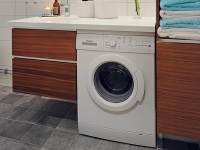
The washing machine is a very important member of the family. For years, these helpers have been working, making life easier for almost every woman. They are bought for years and even centuries. Well, the cost of the washing machine is justified if you choose wisely. In Soviet times there was no choice, but now - the eyes are diverted. How to choose the reliable companion on a field of house affairs?
Types of .
The main way to classify machines - on the type of loading, there are two of them - frontal and vertical. They determine how the door opens and how much space the unit will need as a whole. Each option has its own advantages and weak points. Before choosing, think about where to place the washing machine.
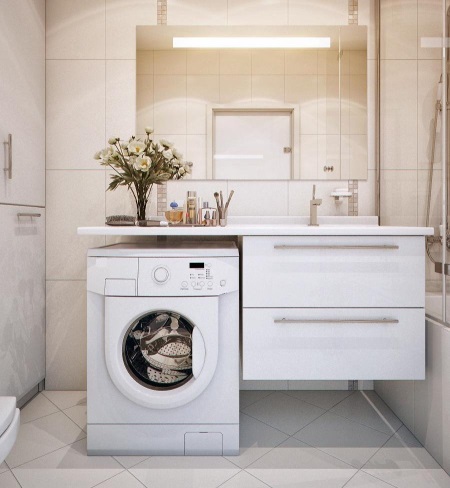
With a vertical load
The advantages of machines with a vertical load can include: large capacity, neat dimensions, convenience, cause less curiosity in small children and pets. It can be "squeezed" into a narrow room, the unit will not flood the apartment.
Vertical loading (lid on top) is considered a good idea: the compact machine allows you to add the forgotten laundry in the process of washing.
The minuses are logical:
- there must be free space on top,
- the machine is not suitable as a working surface,
- the cost is higher.
- Such machines are not distinguished by a beautiful design.
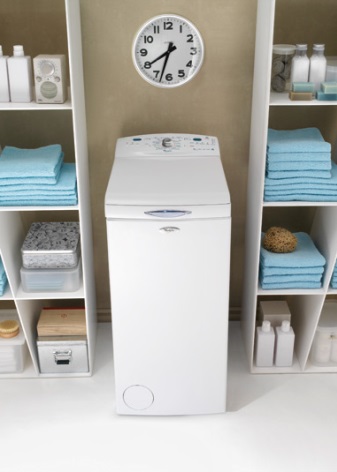

Front loading
Front loading type (the door is placed on the side) is characterized by a wide opening of the door, such a machine needs more space.
Front-loading machines are the favorites of buyers. Manufacturers offer a variety of models and colors, so it is easy to pick up a machine with the right options, based on any budget. The transparent door allows you to watch the washing, the size varies, so it will fit many rooms and easily "hide" in the interior with built-in furniture, will become a convenient countertop. As for the reliability of machines with vertical loading - it is a myth. Each model has its own weak points in the design.
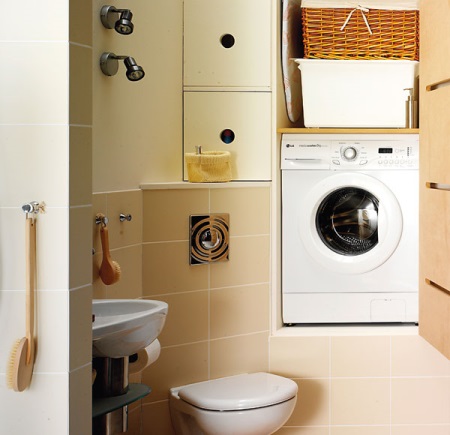
Other classifications
It is common to grade machines according to washing class (the degree of damage to the fibers of the garment in the process), energy efficiency, and spin. Manufacturers use a scale of A-G, the closer to the beginning, the higher the index. The most delicate are A++ and A+, the bestsellers among machines are those of class A and B Such types as C, D and E are inexpensive, they usually have few modes. F and G-classes are the "roughest", they are not loved by either buyers or sellers.
There is a similar division for energy efficiency. The indicators will not necessarily be the same. There are E type washing machines with high energy efficiency ratings (A and A+).
It is also important whether the machine will be freestanding or built-in. The first option can be placed in any room (bathroom, kitchen, hallway), and built-in is typical for rooms where the imagination of the designer or owner can swing. The quality of such machines is higher, but the cost makes them less affordable. О choosing furniture for a built-in washing machine read in another article.
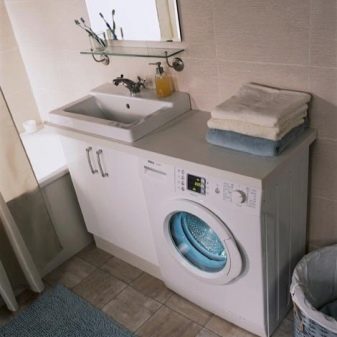
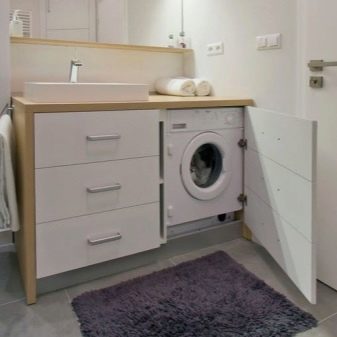
Selection criteria
Usually, the lower the washing class, the less "frills" and the price. Among the extra features there are many that are very useful in life, and there are useless for ordinary people.
Options that you really need:
- Laundry load size. Miniature machines have a small capacity (3-4 kg), so a lot of laundry they will not wash, but for a small family this may be quite enough. But a family of more than 3 people may need a machine with a load capacity of at least 5 kg. Usually enough machine capacity loading up to 7 kg, those that are able to wash 9 or more pounds have to belong to the professional, and the care they do not differ.
- The drive of the machine can be direct, This characterizes the way the motor and the drum are connected, which is beneficial for the buyer. In such models, the energy savings are higher, there is less noise and vibration during operation. An additional advantage is the compactness of the models. The mechanism inside the machine is smaller, and this allows the advantageous use of space. This design is often combined with a large number of additional options, so these machines do not come cheap.
- Spinning and drying. These are good modes, but not necessary for everyone. Spinning at 1000 rpm is optimal for basic types of laundry, for wool, silk and delicate fabrics need less speed, for linen and cotton 1000, maximum 1200 is enough. Anything over is a waste of money (up to 40% of the cost of the machine) and electricity. Drying is necessary for those who forget things in the machine or save space on the dryer (rope) for laundry. This is a little in demand feature, as most things are still ironed, and over-dried laundry is reluctant to undergo this action.
- The class of the washing machine today is determined by energy consumption, spin rate and washing quality. The already familiar gradation determines the cost of the appliance, because this is an essential characteristic. If the energy savings should be at level A, then the other two indicators can be at level B. This is quite a high bid, such machines have many programs, the ability to customize and many functions. They cost more than machines with washing class E by 2-3 times, but hostesses adore them.
- Basic and additional programs. Almost all household appliances are based on smart electronics, sensitive to power surges. But its introduction expands our capabilities. In particular, it allows you to select an existing washing program or change it using additional options. A convenient interface shows which stage of the work is taking place and how much time is left until the end of the whole process. Manufacturers offer about 15 basic types of laundry, the rest - variations by changing the conditions (water temperature, spin speed, duration of washing, etc.). Among the most essential programs: cotton, wool, delicate washing, intensive washing, fast washing, children's items. The other programs may indicate the composition of fabrics or purpose (synthetic, daily, dark items, sports clothes, etc.), they are used less frequently. Machines provide the ability to program their own wash cycle or a single step (rinse, soak, spin).
- Programs for housewives: boiling (for children's clothes) and steam programs. An interesting function "Refresh" is a quick treatment, which dries dry clothes, they can be ironed immediately. "Childproof" will help parents of inquisitive babies. "Foam control" - the function of pausing the cycle, if there was too much powder, the machine waits for the foam to subside and then continues to work. The timer "Delayed start" is liked by the thrifty: it is possible to program the machine to work at night (advantageous on the tariff "day-night"). "Balance control" is convenient when the machine is partly loaded, as well as when the laundry is wrapped in a solid lump. Mass sensors fix the overload of weight and pick up the algorithm of movements so that the laundry is evenly distributed over the drum. This is useful for the appliance itself.
- Leak protection. Even on inexpensive models, there should be some protection, it can be simple ways in the form of a valve on the connecting hoses or sophisticated (water level sensor). Full protection includes a system of measures.
- Noise and materials. Normal noise for washing is not higher than 55dB, for spinning - 70dB. The loudness of the sounds depends on the noise insulation (special material inside the machine that absorbs sound) and materials. For example, models with a plastic drum are generally quieter. Metal is more durable (stainless steel is used), but it makes more noise. Collector-type machines are always louder than asynchronous, so there is a special mode "Silent Washing", which is convenient for night time.
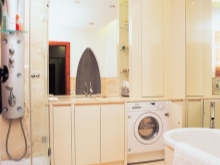

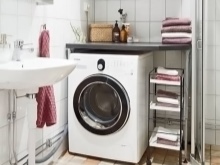
If the room is small
The issue of narrow and compact machines is always relevant. Most manufacturers, have in their range a couple or three models to meet this demand:
- Machines with vertical loading. Their main advantages have already been mentioned earlier. Such machines have a standard height of 85-90 cm, their dimensions - width-depth 40*60, and access is actually needed from one side. The top of the machine must be free, but they do not use the space in front, unlike the front. Models are found in AEG, Bosch, Ariston, Electrolux, Whirlpool.
- Narrow machines have a standard height and width, their depth is 32 cm. This allows you to place the machine in a small bathroom or hallway. Such machines are made by Ariston, Indesit, LG, Samsung, Bosch.
- Small-sized models can be smaller in size (60 cm, depth 40-60 cm, width 50-55 cm), which helps "hide" them in the interior. They are characterized by front loading of laundry. You can find them at Candy and Electrolux.
The last two options are often combined with Pitcher sinks .. Its vertical dimensions are small, about 15 cm. It seems almost flat, but because of the wide surface it successfully performs its functions. You can hide a narrow or compact washing machine under the lily pad, using the space in front of the sink to open the front lid. It looks neat and saves space. Read more in this article about The Dishwasher Sink Fronts Above the Washing Machine..
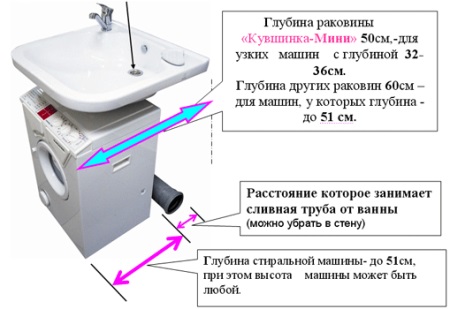
What do I need to remember about over the sink? By cutting out precious centimeters, manufacturers reduce the loading volume and power of the machine, so look out for direct-drive models, where the volume of the machine works for its owner.
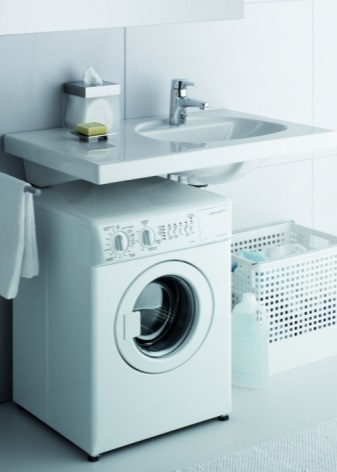
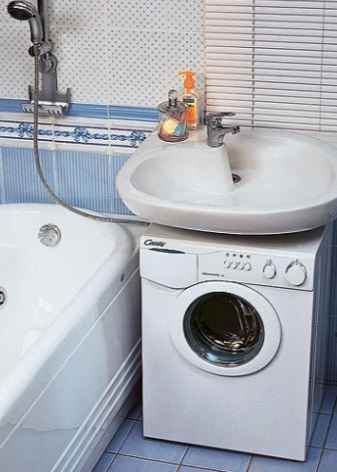
Leading manufacturers.
Price segmentation is found in a number of manufacturers:
- MIELE, AEG, BOSCH, Asko - such appliances have a higher cost, offers built-in models. It is very reliable, but not everyone can afford it.
- WHIRLPOOL, ELECTROLUX, SIEMENS, BRANDT - high-quality and expensive appliances, which have competitors in the next segment. The difference between them in quality exists, but not as big as the differences in price.
- BEKO, ARDO, SAMSUNG, LG, INDESIT, ARISTON, ZANUSSI, CANDY, Hansa - quality mass models.
Other companies offer models at more affordable prices, which is associated with lower quality components, little innovation, lack of additional options, less pleasant design, low power. This is "cheap-hearted" for washing machines, although they have the necessary minimum. For example, Atlant is a domestic brand of household appliances with decent quality.
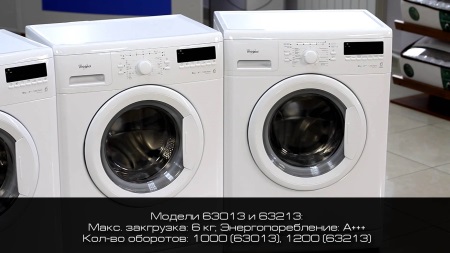
Imposing their pricing policy on consumers by firms does not always follow from quality. Many brands have European roots, carry out assembly in the territory of the European Union. Due to this the cost is greater. Also, the high price can be in high-tech models, which can afford brands that specialize in large appliances (such as BOSCH and ELECTROLUX).
Many eastern firms have good equipment and produce quality appliances, SAMSUNG and LG can be attributed to such.
The most important parameter is how long the company has been in the market of washing machines, on which equipment it specializes more, how actively it innovates and what guarantee it offers for its products. And the rest is a matter of budget and the options you need.
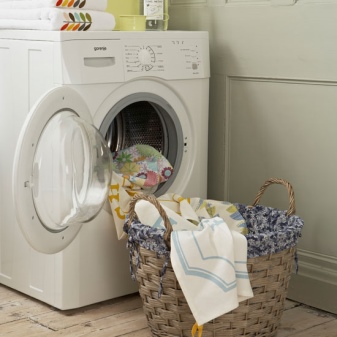
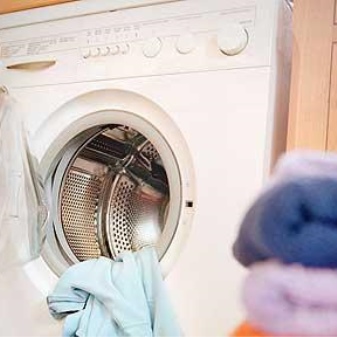
Choosing Tips
When choosing any technique, the buyer wants to be guided by quality and brand, but the size of the wallet will play a decisive role. And yet this purchase is made for the next 10 years. It is worth approaching the question thoroughly.
First of all, focus on the placement of the machine - its parameters will limit your choice. If space allows, then choose a machine with a good energy and washing class.
Keep in mind that a small load will not wash bulky things (plaid, bedspread), they simply will not fit in the drum. The optimum loading index of 5-7 kg (this is the weight of raw laundry), goes with most models.
Choose a model a washing machine that blends seamlessly into your bathroom design.
Ask about warranty and service centers in your city. Unsuccessful models can also happen with luxury manufacturers.
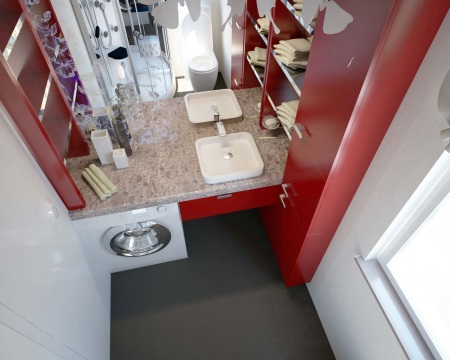
Recommendations for use
A washing machine, stuffed with electronics, is quite a delicate machine. Therefore, you need to remember the golden rule:
- Wash things in the right mode (do not save time on delicate items and respect the temperature for dark and woolen items), this will save their color and shape. Sensitive items also include underwear and items with embroidery.
- Watch out for pockets before washing, you can find special protective covers for delicate items.
- Do not stop washing cycles.
- Fast washing does not allow quality washing of stale and serious stains of dirt.
- There are special powders and capsules for automatic machines, their use will improve the quality of washing. But air conditioners don't like the units, wash the liquid filler tray regularly: it gets dirty quickly.
- Do not use the machine for storing things. The specific smell quickly transfers to the drum.
- If the laundry detergent does not include special chemicals, then at least once a year use descaler powders (turn the machine on a full cycle without laundry).
- Place the machine on a flat floor and plug it into a separate socket.
- Check the filters and air the machine regularly. Stagnant water and debris can cause odors.
What are the details of installing a washing machine Read about the installation of your washing machine in another article.
A washing machine is a great investment, so choose one for your soul and for life. Then your home will be filled with joy!
